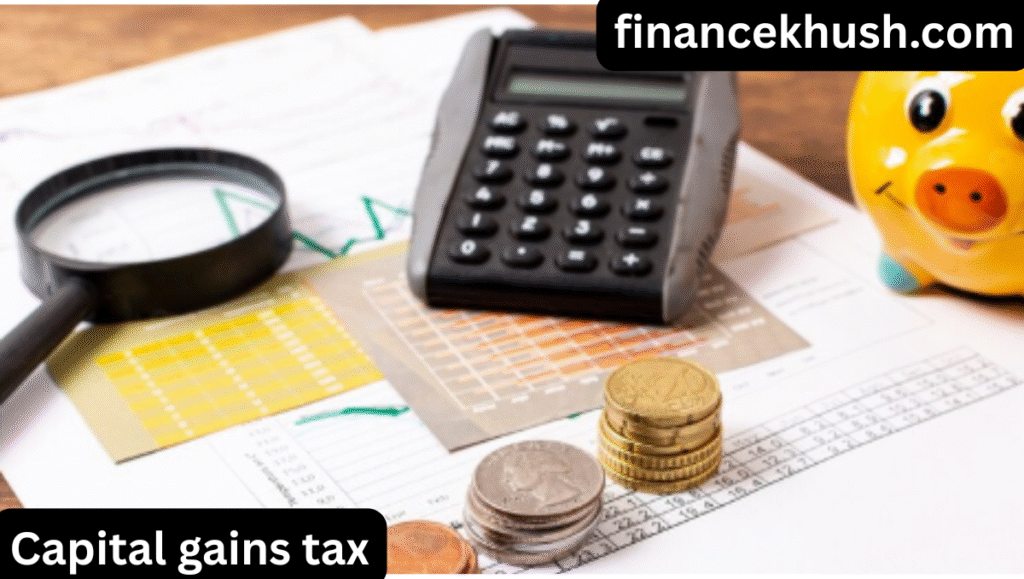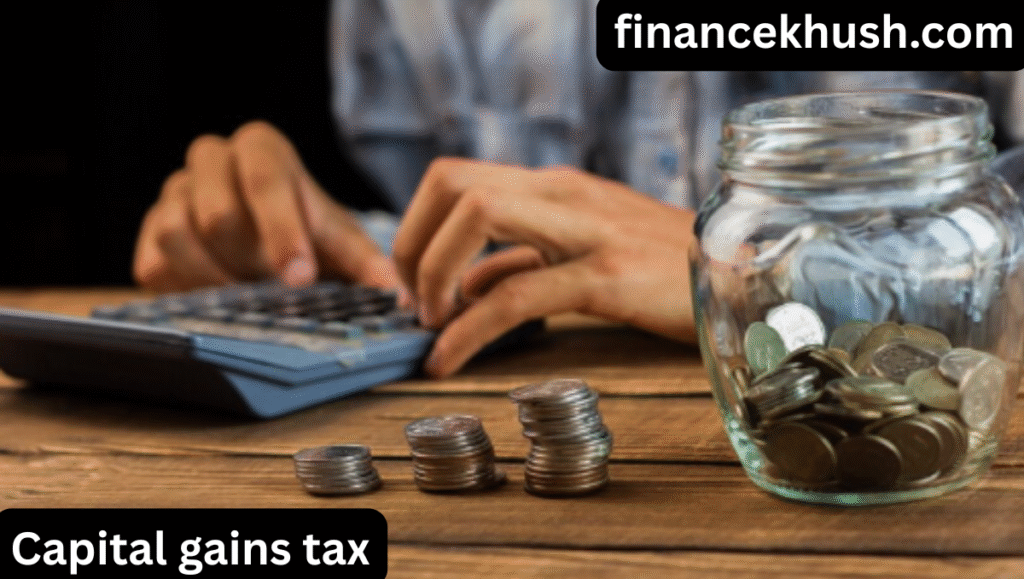Capital gains tax (CGT) can seem like a complex topic, but in reality, it’s something every investor and asset holder should understand. Whether you’re selling a piece of property, stocks, or any other valuable asset, CGT is often a part of the process. This article breaks down the concept of capital gains tax, explaining what it is, how it works, and what you need to know to manage it wisely.
What Is Capital Gains Tax?
In simple terms, capital gains tax is a tax you pay on the profit you make when selling something that has increased in value. For example, if you buy a house for $100,000 and later sell it for $150,000, the $50,000 increase in value is considered a capital gain, and you would be required to pay tax on that gain.
The tax applies to a wide range of assets, including:
- Real Estate: Houses, rental properties, and land
- Stocks and Bonds: Shares in companies or government bonds
- Business Assets: Equipment, intellectual property, and more
- Other Investments: Precious metals, antiques, and other collectibles
Not all assets are taxed in the same way, though, and there are a variety of rules that depend on where you live, how long you’ve owned the asset, and the nature of the asset itself.
Types of Capital Gains
Capital gains are generally categorized into two types:
- Short-Term Capital Gains:
- These gains occur when you sell an asset that you’ve held for one year or less.
- Short-term gains are taxed at a higher rate than long-term gains because the IRS (or equivalent tax authorities in your country) considers them as regular income.
- For example, if you buy stock for $5,000 and sell it within 6 months for $7,000, your $2,000 gain would be subject to short-term capital gains tax.
- These gains occur when you sell an asset that you’ve held for one year or less.
- Long-Term Capital Gains:
- Long-term gains are those made from the sale of an asset held for more than one year.
- These gains are usually taxed at a lower rate compared to short-term capital gains because they’re viewed as more favorable by tax authorities. The logic behind this is that long-term investment is generally encouraged to promote economic growth.
- If you sell that same stock after holding it for 2 years, the $2,000 gain would be taxed at a reduced rate, which could result in significant tax savings.
- Long-term gains are those made from the sale of an asset held for more than one year.
Capital Gains Tax Rates: What You Need to Know
Capital gains tax rates vary widely based on factors like your country’s tax laws, your income level, and how long you’ve held the asset. In the United States, for instance, the tax rates for capital gains are broken down as follows:
Short-Term Capital Gains Rates:
Short-term gains are taxed as ordinary income, which means they’re taxed according to the same income tax brackets that apply to wages, salaries, and other forms of earned income.
- Income Tax Brackets for Ordinary Income (2025):
- 10% to 37% (Depending on your taxable income)
- 10% to 37% (Depending on your taxable income)

Long-Term Capital Gains Rates:
Long-term gains enjoy preferential tax treatment, and the rates are significantly lower than short-term rates.
- Long-Term Capital Gains Rates (2025):
- 0% if your taxable income is below a certain threshold
- 15% for middle-income earners
- 20% for high-income earners
- 0% if your taxable income is below a certain threshold
Here’s an example to give you a clearer picture:
- If you make $50,000 in wages and sell an asset for a $10,000 gain, your long-term capital gain would likely be taxed at 15% (based on current US tax laws).
Additional Considerations:
In some cases, other factors may impact your capital gains tax rate:
- Net Investment Income Tax (NIIT): In the United States, if your income exceeds a certain level (e.g., $200,000 for individuals or $250,000 for married couples), you may be subject to an additional 3.8% tax on your net investment income, which includes capital gains.
- Special Rates on Real Estate: For real estate, you may qualify for exemptions or lower rates depending on the circumstances. For example, in the US, if you live in the property as your primary residence for at least two of the last five years, you may be eligible to exclude up to $250,000 ($500,000 for married couples) of capital gains from the sale of the property.
- Depreciation Recapture: If you’ve claimed depreciation deductions on property you sell (such as rental property), you may face depreciation recapture taxes. This can make the tax on long-term capital gains a bit more complicated.
Why Does Capital Gains Tax Exist?
At its core, capital gains tax exists to tax profits earned from investments. The idea is that if you make money from an asset, that increase in wealth should be subject to tax.
It’s worth noting that this kind of tax is often viewed as a way to redistribute wealth and promote fairness in the economy. Many argue that individuals who profit from investments should contribute to government revenue in a way similar to those who earn wages.
Some also see capital gains taxes as a tool for encouraging long-term investments. By offering a lower tax rate on long-term capital gains, tax authorities encourage people to keep their money invested in assets rather than constantly buying and selling.
Capital Gains Tax and Tax Planning: How to Minimize Your Bill
Though it might seem like a complicated subject, effective tax planning can help you reduce your capital gains tax liability. Here are a few strategies that can potentially lower the taxes you pay when selling an asset:
1. Hold Investments for the Long-Term:
- By holding an asset for more than a year, you can take advantage of the lower long-term capital gains tax rates. It’s one of the simplest and most effective strategies for minimizing your tax bill.
2. Use Tax-Advantaged Accounts:
- In some countries, including the United States, there are tax-advantaged accounts that allow you to defer taxes on capital gains. For example, in the U.S., 401(k) and IRA accounts allow you to grow investments tax-deferred, meaning you don’t have to pay capital gains tax until you withdraw the funds.
3. Offset Gains with Losses (Tax-Loss Harvesting):
- If you’ve sold some assets at a loss, you can use those losses to offset your gains and reduce your taxable income. This is called tax-loss harvesting, and it’s a common strategy used by investors to lower their capital gains tax burden.
4. Utilize Exemptions:
- For certain assets like your primary residence, you might be able to exclude a portion of the capital gains from taxation. In the U.S., for instance, the home sale exclusion allows you to exclude up to $250,000 of gain ($500,000 for married couples) if the home was your primary residence for at least two years out of the five years prior to the sale.
5. Gifting Assets:
- If you want to pass on assets to family members, consider gifting them instead of selling them. When you gift assets, the capital gains tax may be deferred, or in some cases, entirely avoided, depending on the laws in your country. Keep in mind that gift tax rules vary.
Real-Life Example: Understanding Capital Gains Tax in Action
Let’s consider a practical example to understand how capital gains tax works:
Scenario 1:
You buy 100 shares of stock at $20 per share, for a total of $2,000. After 2 years, the stock’s value rises to $40 per share, and you decide to sell. Your total selling price is $4,000.
- Capital Gain: $4,000 (selling price) – $2,000 (purchase price) = $2,000
- Holding Period: 2 years (so it’s a long-term capital gain)
- Tax Rate: Let’s assume a 15% long-term capital gains tax rate.
Your capital gains tax would be:
- $2,000 x 15% = $300
So, after taxes, your profit from this sale would be $1,700.
Scenario 2:
Now, if you had sold the same shares within 6 months of purchasing them, your $2,000 gain would have been taxed at a higher short-term capital gains rate of 25% (for example).
Your capital gains tax would be:
- $2,000 x 25% = $500
In this scenario, you would be left with $1,500 after taxes.

Conclusion:
Capital gains tax might seem complicated at first glance, but once you understand the basics, it becomes much easier to navigate. Whether you’re investing in real estate, stocks, or any other assets, being aware of how capital gains tax works can help you make informed decisions and potentially save money in the long run.
read more
- https://financekhush.com/mobile-banking-a-comprehensive-guide-2025/
- https://financekhush.com/how-to-build-a-culture-of-compliance-in-2025/
Faq’s
1. What is capital gains tax?
Capital gains tax is a tax you pay when you make a profit from selling something valuable, like a house, stock, or land. If you sell something for more than what you paid for it, the profit is considered a “capital gain,” and you’ll need to pay taxes on that gain.
2. How is capital gains tax calculated?
Capital gains tax is based on the profit you make from selling an asset. For example, if you buy a house for $100,000 and sell it for $150,000, your gain is $50,000. How much tax you pay depends on how long you’ve owned the asset and your income level.
- Short-Term Capital Gains: If you sell something within a year, your gains are taxed like regular income (higher rate).
- Long-Term Capital Gains: If you hold the asset for more than a year, you usually get taxed at a lower rate.
3. Do I always have to pay capital gains tax when I sell something?
Not always! You may not have to pay capital gains tax if you qualify for certain exemptions. For example, if you sell your primary home and have lived there for at least 2 out of the last 5 years, you can exclude up to $250,000 of the gain ($500,000 for married couples).
Also, if you sell something at a loss, you can use that loss to offset other gains, reducing your tax bill.
4. What’s the difference between short-term and long-term capital gains?
The key difference is how long you hold the asset:
- Short-Term: If you sell the asset within a year, the tax rate is higher.
- Long-Term: If you sell the asset after holding it for over a year, you get a lower tax rate.
So, the longer you hold the asset, the lower the tax rate on your gains!
5. How can I reduce my capital gains tax bill?
There are a few ways to reduce your capital gains tax:
- Hold onto investments longer: The longer you hold, the lower the tax rate.
- Use tax-advantaged accounts: Accounts like IRAs or 401(k)s can help defer or avoid taxes.
- Offset gains with losses: If you have losses from other investments, you can use them to reduce your taxable gains (called tax-loss harvesting).
6. How much capital gains tax will I pay?
The amount you pay depends on two main factors:
- How long you held the asset: Short-term gains are taxed at regular income tax rates, while long-term gains are taxed at a lower rate.https://financeforu.com/
- Your income level: The higher your income, the higher the tax rate on your capital gains.

2 thoughts on “How Capital Gains Tax Affects Your Investment Strategy in 2025 ”